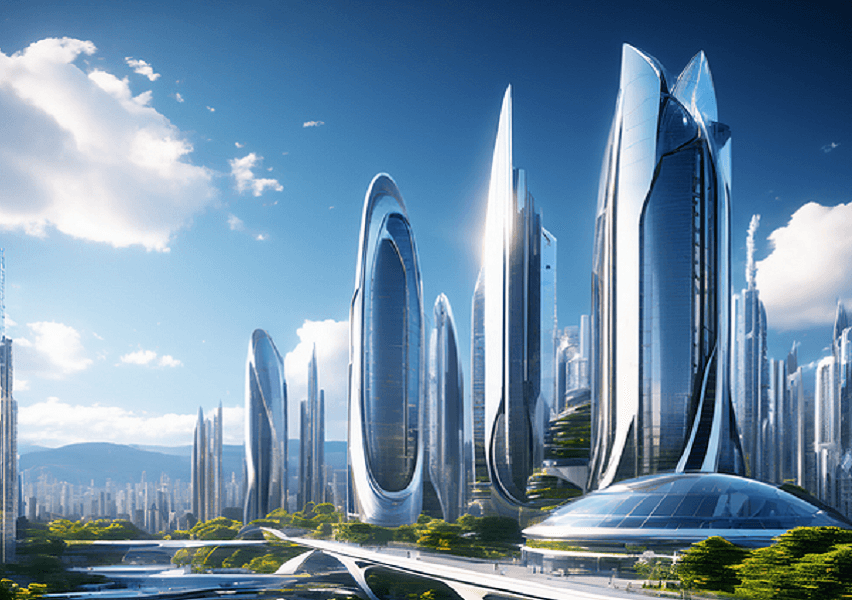
Innovations in materials have a profound impact on the future of architecture, enabling architects and designers to push the boundaries of creativity, sustainability, and performance. Here are some key innovations in materials that are shaping the future of architecture:
- Smart Materials: Smart materials are engineered to respond to external stimuli, such as temperature, light, moisture, or mechanical stress, in a controlled and predictable manner. Examples include shape-memory alloys, self-healing concrete, and thermochromic glass. Smart materials offer opportunities for adaptive and responsive architecture, allowing buildings to adjust their properties and performance dynamically in response to changing environmental conditions.
- Carbon-Fiber Composites: Carbon-fiber composites are lightweight, high-strength materials that offer exceptional structural performance and design flexibility. Architects use carbon-fiber composites in building components such as facades, roofs, bridges, and canopies to achieve slender profiles, long spans, and innovative forms. Carbon-fiber composites enable the construction of lightweight and sustainable structures with reduced material usage and energy consumption.
- Biodegradable and Recyclable Materials: As sustainability becomes increasingly important in architecture, there is growing interest in biodegradable and recyclable materials that minimize environmental impact and promote circularity. Bioplastics, bio-based polymers, and plant-based materials offer alternatives to conventional building materials derived from fossil fuels. Architects incorporate biodegradable and recyclable materials in building construction, interiors, and finishes to reduce waste, pollution, and resource depletion.
- 3D-Printed Materials: 3D printing technology has revolutionized the production of complex geometries and customized components in architecture. Architects use 3D-printed materials, such as concrete, clay, plastic, and metal, to fabricate building elements with intricate shapes, intricate details, and optimized performance. 3D printing enables rapid prototyping, mass customization, and on-site fabrication, reducing construction time, costs, and material waste.
- Nanomaterials: Nanomaterials are engineered at the nanoscale to exhibit unique properties, such as strength, conductivity, and transparency, that surpass those of conventional materials. Architects incorporate nanomaterials, such as graphene, carbon nanotubes, and aerogels, in building components like coatings, membranes, and insulation to enhance performance and sustainability. Nanomaterials offer opportunities for energy-efficient buildings, improved indoor comfort, and enhanced durability.
- Transparent and Translucent Materials: Transparent and translucent materials, such as glass, ETFE (ethylene tetrafluoroethylene), and acrylics, are increasingly used in architectural facades, roofs, and skylights to maximize daylighting, views, and visual connections with the outdoors. Advances in glass technology, such as switchable glass, self-cleaning coatings, and energy-efficient glazing, improve the performance and aesthetics of transparent building envelopes.
- Biomimetic Materials: Biomimetic materials are inspired by biological systems and processes found in nature, such as self-assembly, hierarchical structures, and adaptive responses. Architects explore biomimetic principles in material design, fabrication techniques, and building systems to create sustainable, resilient, and regenerative architecture. Biomimetic materials offer insights into efficient resource use, natural resilience, and ecological adaptation, informing innovative solutions for the built environment.
- Cross-Laminated Timber (CLT): Cross-laminated timber (CLT) is a sustainable, renewable building material made from layers of timber boards stacked and glued together in alternating directions. CLT offers structural strength, fire resistance, and aesthetic appeal, making it suitable for a wide range of building applications, including walls, floors, and roofs. Architects embrace CLT as a low-carbon alternative to traditional building materials, contributing to the promotion of timber construction and the reduction of carbon emissions in the built environment.
Conclusion: These innovations in materials are transforming the practice of architecture, enabling architects and designers to create buildings and spaces that are more sustainable, resilient, and responsive to the needs of users and the environment. By embracing new materials and technologies, architects can shape a future built environment that is both innovative and environmentally responsible.


